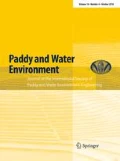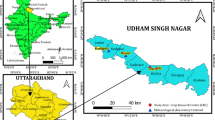Abstract
Due to the pressure on water resources, especially in agricultural sectors, evaluation of the effective strategies on decrease in water consumption has an applicable and important role in field water management. In this research, the effectiveness rate of the 7 climatic parameters on the water requirement of barley (amount of potential evapotranspiration of barley (PETB) during the growth period) using the random forest algorithm (RF), Bayesian multiple linear regression (BR) and cross-correlation function (CCF) was investigated and prioritized. The results of this research can help the managers to control effective climatic variables on PETB. In this paper, the climatic data series of 8 stations with different climate conditions (with two replicates for each climate condition) in Iran during 1968–2017 was used. The results showed the linear regression of simulated PETB using AquaCrop model and predicted PETB using the RF and BR models had no difference with perfect reliable in 0.05 significant levels (T-Statistics varies from 0.010–0.103 and 0.000–0.842 in BR and RF models, respectively, and the R-square (R2) between simulated and predicted PETB were significant in 0.01 levels at all stations (R2 varies from 0.843–0.996 and 0.930–0.999 in BR and RF models, respectively; therefore, the RF and BR models had a good accuracy to predict PETB based on the climatic parameters and the accuracy of RF was more than BR model. The results indicated that based on the all statistical methods the wind speed had the most impact on the PETB (at 62.5% of stations) and based on the RF, BR and CCF methods the average of minimum temperature, the average of sunshine and the average of precipitation had the lowest impact on the PETB, respectively.





Similar content being viewed by others
References
Abbasi AR, Mahmoudi MR, Avazzadeh Z (2018) Diagnosis and clustering of power transformer winding fault types by cross-correlation and clustering analysis of FRA results. IET Gener Transm Distrib 12(19):4301–4309
Acharjee TK, van Halsema G, Ludwig F, Hellegers P, Supit I (2019) Shifting planting date of Boro rice as a climate change adaptation strategy to reduce water use. Agric Syst 168:131–143
Akar T, Avci M, Dusunceli F (2004) BARLEY: post-harvest operations, Food and Agriculture Organization (FAO), P 4
Ararssa AA, Gebremariam AG, Mulat WL, Mekonnen MM (2019) Effects of Irrigation management on yield and water productivity of barley hordeum vulgare in the Upper Blue Nile Basin: case study in Northern Gondar. In: Water conservation science and engineering, pp 1–9. https://doi.org/10.1007/s41101-019-00071-8
Ardakani Z, Bartolini F, Brunori G (2019) Economic modeling of climate-smart agriculture in Iran: new medit: mediterranean journal of economics, agriculture and environment. Revue Méditerranéenne d’economie, Agriculture et Environment 18(1):29–40
Awal R, Fares A (2019) Potential impact of climate change on irrigation water requirements for some major crops in the Northern High Plains of Texas. In: Bridging among disciplines by synthesizing soil and plant processes (bridgingamongdi). https://doi.org/10.2134/advagricsystmodel8.2017.0014
Bertolino LT, Caine RS, Gray JE (2019) Impact of stomatal density and morphology on water-use efficiency in a changing world. Front Plant Sci. https://doi.org/10.3389/fpls.2019.00225
Daničić M, Zekić V, Mirosavljević M, Lalić B, Putnik-Delić M, Maksimović I, Dalla Marta A (2019) The response of spring barley (Hordeum vulgare L.) to climate change in Northern Serbia. Atmosphere 10(1):14
Danish Agriculture and Food Council (2017) The agriculture and food market in Iran, opportunities and challenges for Danish companies, The Royal Danish Embassy in Tehran
Doğan HG, Kan A (2019) The effect of precipitation and temperature on wheat yield in Turkey: a panel FMOLS and panel VECM approach. Environ Dev Sustain 21(1):447–460
Fang J, Su Y (2019) Effects of soils and irrigation volume on maize yield, irrigation water productivity, and nitrogen uptake. Sci Rep 9(1):7740
Faostat F (2016) Agriculture organization of the united nations statistics division 2014. http://faostat3.fao.org/browse/Q/QC/S. Review date: April 2015
Fereres E, García-Vila M (2019) Irrigation management for efficient crop production. Crop Sci. https://doi.org/10.1007/978-1-4939-8621-7-162
Fonseca VA, Santos MRD, Silva JAD, Donato SLR, Rodrigues CS, Brito CFB (2019) Morpho-physiology, yield, and water-use efficiency of Opuntia ficus-indica irrigated with saline water. Acta SciAgron. https://doi.org/10.4025/actasciagron.v41i1.42631
Food and Agriculture Organization (2003) Agriculture, food, and water: a contribution to the world water development report
Gebru KM, Rammelt C, Leung M, Zoomers A, van Westen G (2019) Inclusive malt barley business and household food security in Lay Gayint district of northern Ethiopia. Food Secur. https://doi.org/10.1007/s12571-019-00939-6
Goodarzi M, Abedi-Koupai J, Heidarpour M (2019) Investigating impacts of climate change on irrigation water demands and its resulting consequences on groundwater using CMIP5 models. Groundwater 57(2):259–268
Guo D, Zhao R, Xing X, Ma X (2019) Global sensitivity and uncertainty analysis of the AquaCrop model for maize under different irrigation and fertilizer management conditions. Arch Agron Soil Sci. https://doi.org/10.1080/03650340.2019.1657845
Hasan MR, Nuruzzaman M, Mamun AA (2019) Contribution of rainwater to the irrigation requirement for paddy cultivation at Tanore Upazila in Rajshahi, Bangladesh. Air Soil Water Res 12:1178622119837544. https://doi.org/10.1177/1178622119837544
Huang H, Han Y, Jia D (2019) Impact of climate change on the blue water footprint of agriculture on a regional scale. Water Sci Technol Water Supply 19(1):52–59
Islam AT, Shen S, YangS HuZ, Chu R (2019) Assessing recent impacts of climate change on design water requirement of Boro rice season in Bangladesh. Theor Appl Climat. https://doi.org/10.1007/s00704-019-02818-8
Jami A, Tasumi M, Mosier TM, Somura H, Konishi T (2019) Evaluation of the effects of climate change on field-water demands using limited ground information: a case study in Balkh province, Afghanistan. Irrigat Sci. https://doi.org/10.1007/s00271-019-00638-2
Jia H, Zhang T, Yin X, Shang M, Chen F, Lei Y, Chu Q (2019) Impact of climate change on the water requirements of oat in Northeast and North China. Water 11(1):91
Lee HL (2009) The impact of climate change on global food supply and demand, food prices, and land use. Paddy Water Environ, 7(4):321
Loeve R, Hong L, Dong B, Mao G, Chen CD, Dawe D, Barker R (2004) Long-term trends in intersectoral water allocation and crop water productivity in Zhanghe and Kaifeng, China. Paddy Water Environ, 2(4):237–245
Mahdavi M (2002) Applied hydrology, vol 2. Tehran University Press, Tehran, p 40
Masasi B, Taghvaeian S, Gowda PH, Warren J, Marek G (2019) Simulating soil water content, evapotranspiration, and yield of variably irrigated grain sorghum using aquacrop. JAWRA J Am Water Resour Assoc. https://doi.org/10.1111/1752-1688.12757
Mohamed EA, Mohamed MA, Musa LM (2019) Determination of crop water requirements and irrigation scheduling of aerobic rice (Oryza sativa L.), Gezira Conditions. Sudan. Afr J Rural Dev 3(2):747–752
Mohammad-Vali-Samani J (2005) Water resources management and sustainable development. Infrastructure Studies Office of the Islamic Consultative Assembly. Report No. 7374 (in Persian)
Mokarram M, Hamzeh S, Aminzadeh F, Zarei AR (2015) Using machine learning for land suitability classification. West Afr J Appl Ecol 23(1):63–73
Mungkung R, Gheewala SH, Silalertruksa T, Dangsiri S (2019) Water footprint inventory database of Thai rice farming for water policy decisions and water scarcity footprint label. Int J Life Cycle Assess. https://doi.org/10.1007/s11367-019-01648-0
Pirmoradian N, Davatgar N (2019) Simulating the effects of climatic fluctuations on rice irrigation water requirement using AquaCrop. Agric Water Manag 213:97–106
Qasemipour E, Abbasi A (2019) Assessment of agricultural water resources sustainability in arid regions using virtual water concept: case of South Khorasan Province, Iran. Water 11(3):449
Ramezani M, Babazadeh B, Tabrizi Sarai (2019) Simulating barley yield under different irrigation levels by using AquaCrop model. J Irrig Sci Eng 41(4):161–172
Rudolf R (2019) The impact of maize price shocks on household food security: panel evidence from Tanzania. Food Policy 85:40–54
Sadatinejad SJ, Hassanshahi R, Shayannejad M, Abdolahi K (2011) Evaluation of Fuzzy regression efficiency for reconstructing missing annual precipitation data in Karoon basin. Environ Sci 8(3):109–116
Shiferaw B, Negassa A, Koo J, Braun HJ, Sonder K, Guo Z, Payne T, Wood S (2019) Wheat for food security in Africa: biophysical potential, economic profitability and competitiveness of domestic production. Gates Open Res. https://doi.org/10.21955/gatesopenres.1115629.1
Shirshahi F, Babazadeh H, Ebrahimipak N, Zeraatkish Y (2018) Calibration and assessment of AquaCrop Model For Managing the quantity and time of applying wheat deficit irrigation. Irrig Sci Eng 4(1):31–44
Shumway RH, Stoffer DS (2011) Time series analysis and its applications. Springer, New York
Svanidze M, Götz L, Djuric I, Glauben T (2019) Food security and the functioning of wheat markets in Eurasia: a comparative price transmission analysis for the countries of Central Asia and the South Caucasus. Food Secur. https://doi.org/10.1007/s12571-019-00933-y
Tavakoli AR, Moghadam MM, Sepaskhah AR (2015) Evaluation of the AquaCrop model for barley production under deficit irrigation and rainfed condition in Iran. Agric Water Manag 161:136–146
United Nations Environment Programme (UNEP) (1992) World atlas of desertification. Edward Arnold, London
Venables WN, Ripley BD (2002) Modern applied statistics with S, 4th edn. Springer, Berlun
Xu H, Tian Z, He X, Wang J, Sun L, Fischer G, Fan D, Zhong H, Wu W, Pope E, Kent C (2019) Future increases in irrigation water requirement challenge the water-food nexus in the northeast farming region of China. Agric Water Manag 213:594–604
Yawson DO, Adu MO, Mulholland B, Ball T, Frimpong KA, Mohan S, White PJ (2019) Regional variations in potential groundwater recharge from spring barley crop fields in the UK under projected climate change. Groundw Sustain Dev 8:332–345
Zarei AR, Moghimi MM (2019a) Modified version for SPEI to evaluate and modeling the agricultural drought severity. Int J Biometeorol 63(7):911–925
Zarei AR, Moghimi MM (2019b) Environmental assessment of semi-humid and humid regions based on modeling and forecasting of changes in monthly temperature. Int J Environ Sci Technol 16(3):1457–1470
Zarei AR, Mahmoudi MR (2020) Prioritization of the effectiveness rate of various climatic variables on the annual yield of rain-fed winter wheat using different statistical models. Stoch Env Res Risk Assess 34(5):611–625
Zarei AR, Shabani A, Mahmoudi MR (2019) Comparison of the climate indices based on the relationship between yield loss of rain-fed winter wheat and changes of climate indices using GEE model. Sci Total Environ 661:711–722
Zhou MX (2009) Barley production and consumption. In: Genetics and improvement of barley malt quality. Springer, Berlin, pp 1–17
Acknowledgements
The authors thank the Iranian Meteorological Organization (IMO) for providing the necessary climatic data.
Author information
Authors and Affiliations
Corresponding author
Ethics declarations
Conflict of interest
The authors of this paper declare that they have no conflict of interest.
Rights and permissions
About this article
Cite this article
Zarei, A.R., Mahmoudi, M.R. & Shabani, A. Investigating of the climatic parameters effectiveness rate on barley water requirement using the random forest algorithm, Bayesian multiple linear regression and cross-correlation function. Paddy Water Environ 19, 137–148 (2021). https://doi.org/10.1007/s10333-020-00825-4
Received:
Revised:
Accepted:
Published:
Issue Date:
DOI: https://doi.org/10.1007/s10333-020-00825-4




